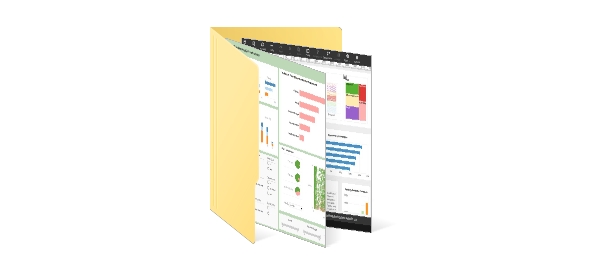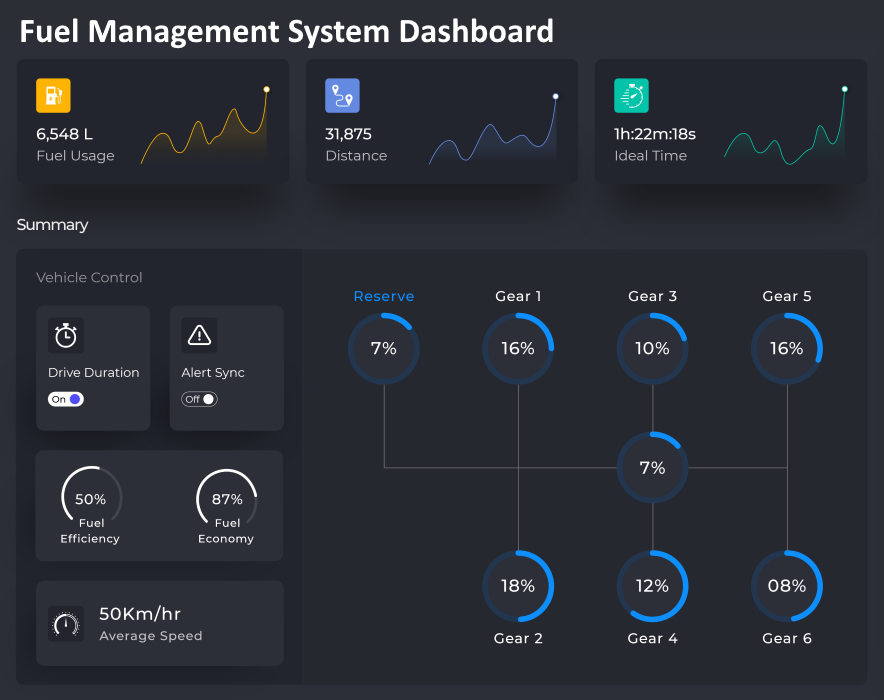What KPIs and Analytics Are Used on Fuel Management System Dashboards?
Fuel management systems are essential for maximizing fuel efficiency, cutting expenses, and guaranteeing equipment and vehicle performance. Organizations use a range of Key Performance Indicators (KPIs) on the dashboards of their fuel management systems to accomplish these goals.
These KPIs provide insightful information on fuel use, effectiveness, and overall performance.
| #1 Ranking: Read how InetSoft was rated #1 for user adoption in G2's user survey-based index | Read More |
Fuel Consumption Rate
The fuel consumption rate is one of the main KPIs tracked on fuel management system dashboards. This statistic assists companies in monitoring the fuel consumption of their equipment or vehicles over a certain time frame. Businesses may make educated judgments to optimize fuel use by identifying patterns, trends, and anomalies in fuel usage by studying this data. Keeping an eye on the rate at which gasoline is used is essential for managing expenses, cutting down on waste, and putting plans into action to improve fuel economy overall.
Fuel Efficiency and MPG (Miles Per Gallon)
For businesses looking to save expenses and their carbon impact, fuel economy is a vital component. Tracking miles per gallon (MPG) is a crucial KPI that sheds light on how well cars use gasoline. Better fuel economy is indicated by a higher MPG number, which enables businesses to discover cars or equipment that could need maintenance or changes to function better. By concentrating on this KPI, businesses may put policies in place like routine maintenance, driver education, and route optimization to improve overall fuel economy and save costs associated with gasoline.
Analyzing Data for Effective Decision-Making in Fuel Management Systems
Analytics are essential for giving firms a better knowledge of their fuel management systems than just KPIs. With the use of sophisticated data analysis tools, businesses can better understand the large amounts of data produced by these systems and make more educated decisions while increasing overall productivity.
Real-time Monitoring and Alerts
A vital component of fuel management systems is real-time monitoring, which enables businesses to keep tabs on fuel use and performance as things happen. Instantaneous warnings to stakeholders are triggered by real-time analytics, which facilitates the prompt identification of anomalies or inefficiencies. For example, unexpected increases in gasoline use or illicit fuel transfers may be reported instantly, enabling businesses to respond quickly to resolve problems and save any losses.
Predictive Analytics for Maintenance
Using machine learning algorithms and historical data, predictive analytics foresees possible problems and trends in fuel management systems. Organizations may minimize downtime and avoid unplanned failures by predicting when maintenance is likely to be needed by evaluating trends in equipment performance. Predictive analytics optimizes maintenance plans and reduces unscheduled repairs, which not only increases the dependability of machinery and automobiles but also lowers costs.
Integration with Fleet Management Systems
Fleet management and efficient fuel management often go hand in one. Fleet management systems may provide a full picture of vehicle performance, driver behavior, and fuel use by integrating fuel management system analytics with them. With the use of this integrated approach, companies are able to pinpoint the relationships between driving behaviors and fuel economy, paving the way for focused interventions like driver education initiatives. Organizations may increase overall efficiency, simplify operations, and make well-informed choices that have a favorable financial effect by evaluating the comprehensive data from both platforms.
The Role of Dashboards in Fuel Management Analytics
Dashboards act as a conduit between the end users who are in charge of making decisions and the complicated data produced by fuel management systems. These data visualisations make it easier to understand KPIs and statistics, enabling stakeholders to swiftly get insights and make well-informed decisions.
User-friendly Visualizations
Heat maps, graphs, and other user-friendly visualizations are used by fuel management dashboards to display complicated data in a way that is simple to comprehend. With the use of these visual aids, stakeholders may quickly and more efficiently make decisions by identifying patterns, anomalies, and correlations. Organizations may enhance their transportation strategy by using a graphical depiction of fuel consumption trends across several routes.
 |
Learn about the top 10 features of embedded business intelligence. |
Customization for Stakeholder Needs
Good fuel management dashboards include customization choices so that users may adjust the data to suit their own requirements. Different insights may be needed by fleet managers, financial teams, and maintenance staff depending on their positions within the company. With customizable dashboards, all stakeholders are guaranteed access to the most up-to-date information, which improves their capacity to make choices that are in line with their duties.
Historical Performance Tracking
Dashboards make it easier to monitor past performance in addition to provide real-time data. Organizations may make proactive decisions by identifying long-term trends and patterns via the analysis of historical data. For example, knowing how fuel economy has changed over a few months might help with strategic choices about new car purchases, maintenance plans, or fuel purchase agreements.
Fuel Cost per Mile
For businesses trying to minimize their operating costs, knowing the cost of gasoline per mile is essential. This statistic is figuring out how much gasoline a car uses for every mile it drives. Organizations may evaluate the performance of various cars, find inefficiencies, and put policies into place to lower total fuel expenses by tracking fuel cost per mile. Particularly useful for fleets with a variety of vehicle types and use patterns is this KPI.
Idle Time Percentage
The period of time an engine runs when a car is not moving is referred to as idle time. An excessive amount of idle time might waste a lot of gasoline. Organizations may evaluate the effectiveness of their fleet operations by keeping an eye on the idle time %, which is a useful KPI. Businesses may reduce fuel consumption by using strategies like driver training or technological solutions to decrease unneeded engine idling by recognizing cars with excessive idle durations.
 |
Read the top 10 reasons for selecting InetSoft as your BI partner. |
Fuel Dispensing Accuracy
Fuel dispensing accuracy is a crucial KPI for businesses with on-site fueling infrastructure. It gauges the accuracy of gasoline dispensing, guaranteeing that the quantity delivered corresponds to actual fuel use. Inaccuracies in the gasoline distribution process might affect overall operating efficiency and result in financial losses. Maintaining correct fuel inventory records and ensuring the integrity of the fuelling process are two benefits of regular monitoring this KPI for enterprises.
Geo-fencing and Location Analytics
Setting virtual limits around certain geographic locations is known as geo-fencing, and location analytics makes use of the data that these boundaries collect. Geo-fencing enables fuel management systems to track the movements of cars inside designated zones. This cutting-edge analytics method improves overall fleet security, finds illicit fuel transfers, and optimizes routes. Organizations may get a thorough picture of fuel use trends in various locations by merging fuel consumption indicators with geo-fencing data.
Fuel Quality Analytics
Maintaining the health of vehicles and equipment requires fuel quality analysis. Analyzing gasoline quality entails keeping an eye on variables including water content, octane levels, and impurities. Utilizing laboratory results and sensor data, businesses can pinpoint fuel quality problems that might affect engine performance. Proactive maintenance is made possible by timely analysis of fuel quality data, which lowers the possibility of engine damage and maximizes overall operating efficiency.
Carbon Emission Tracking
Organisations are increasingly prioritising the monitoring and reduction of carbon emissions from their fleets in order to align with environmental sustainability objectives. Carbon emissions linked to gasoline usage may be monitored using sophisticated analytics methods. Organizations may find chances to adopt environmentally friendly practices, including route optimization, fuel-efficient vehicle upgrades, or alternative fuel source investments, by examining this data. Beyond only saving money, measuring carbon emissions helps a business show its commitment to environmental responsibility.
 |
View the gallery of examples of dashboards and visualizations. |
Driver Behavior Analytics
It is essential to comprehend driving behavior in order to maximize fuel economy and guarantee vehicle safety. Fuel management dashboards with driver behavior analytics may shed light on things like hard braking, acceleration, and speeding. Organizations may identify drivers who would benefit from extra coaching or training to increase fuel economy by keeping an eye on these habits. This KPI improves overall fleet safety while also helping to save costs.
Fuel Procurement Analysis
Purchasing fuel represents a substantial operating expense for businesses with big fleets. Analytics for gasoline procurement, such as monitoring fuel costs, negotiating contracts, and evaluating supplier performance, may be included in fuel management dashboards. Organizations may improve their fuel procurement strategy, negotiate better contracts, and decide whether to lock in gasoline rates by reviewing past procurement data.



